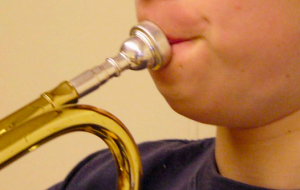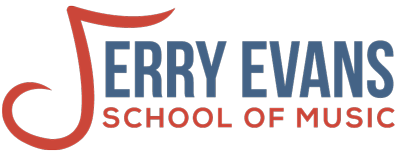My name is Zachary Belles, and I recently starting teaching the students in our brass program here at the JESM. There are many things that define a brass player whether it be trumpet, trombone, tuba, or any other instrument in the brass family. However, when someone first picks up an instrument they might ask themselves how to best expedite the process of learning. I’ve noticed that at the earliest stages of growth in brass, the most important skill to focus on is embouchure. Embouchure, as defined by Professor James Ketch at the University of North Carolina, Chapel Hill, is “putting together the mouthpiece, lips, facial muscles, oral cavity, and air stream [together] to produce sound”. If students do not learn proper embouchure from the beginning, serious tone and range problems can and will occur in later on. Let’s take a look at the good, the bad, and the ugly of embouchure!
“If you were to draw a picture of a face and a [brass instrument] on a piece of paper, there would be perfectly equal distribution on all four quadrants” says Professor Ketch once again in regards to properly forming correct embouchure. But  what exactly does this mean? If you look at the first image, you can see that the two lines intersecting the circle are at the direct center of the lips. These lines separate the circle into four equal parts or “quadrants,” if you remember what that is back from high school geometry. The exact center is where the sound should come from. This goes for all brass instruments, except for French horn. In the
what exactly does this mean? If you look at the first image, you can see that the two lines intersecting the circle are at the direct center of the lips. These lines separate the circle into four equal parts or “quadrants,” if you remember what that is back from high school geometry. The exact center is where the sound should come from. This goes for all brass instruments, except for French horn. In the  second image, you will see that the lips should be ⅔ for the upper lip and ⅓ for the lower lip to form a proper embouchure. The biggest challenge I’ve observed is how exactly to “buzz” or play into the mouthpiece or instrument.
second image, you will see that the lips should be ⅔ for the upper lip and ⅓ for the lower lip to form a proper embouchure. The biggest challenge I’ve observed is how exactly to “buzz” or play into the mouthpiece or instrument.
When forming the embouchure, students should start by making an “M” shape with their mouth and keep the corners very firmly shut but not too tight where the muscles “lock up” in a sense. This can be a bit of a challenge for new students, so there are few ways to think about it before putting their mouths to the instrument. One way to start out is by humming the notes while making the shape with their mouths. From there, they can start doing this with their mouthpieces and “buzzing” by making said “M” shape and vibrating the middle of their lips. This is a great way to form a proper embouchure before putting the mouthpiece on the instrument. According to Robert Vriezen at Yorkville High School in Yorkville, Illinois, a key thing to note is to make sure the student brings their mouth to their mouthpiece and not the other way around.
What happens when a student develops a bad embouchure habit? One of the first things that can be noticed is the lack of ability to play higher notes. This can be from the angle of the instrument being too low on the students face, or too much of a “smile”. While the “smile” and “M” are very important in the forming of the embouchure, too much and too tight of a smile can result in this problem occurring in the later stages of learning. Another thing that can easily be noticed is the tone quality when playing. Tone quality or “timbre” is defined by Georgia State University Professor of Physics Rod Nave as “characteristics of sound which allow the ear to distinguish sounds which have the same pitch and loudness”.
Another possible sign is actually a side effect of the instrument angle and timbre. A lot of students who struggle to reach higher notes on their instrument  will often press the mouthpiece harder onto their mouth. This will spread their tone thin and make it more difficult for them to produce higher notes later on. I have also seen students with strained tone and a forced sound. This can be caused by many things, but according to Cynthia Plank on her “Embouchure Study – Trumpet” at the Western International Band clinic in 2014, this is mainly caused by curled-in and uneven lips. The lips are very important in the embouchure building process. If the lips are curled in or unevenly distributed, tone quality and range can suffer.
will often press the mouthpiece harder onto their mouth. This will spread their tone thin and make it more difficult for them to produce higher notes later on. I have also seen students with strained tone and a forced sound. This can be caused by many things, but according to Cynthia Plank on her “Embouchure Study – Trumpet” at the Western International Band clinic in 2014, this is mainly caused by curled-in and uneven lips. The lips are very important in the embouchure building process. If the lips are curled in or unevenly distributed, tone quality and range can suffer.
Now, we have gone over many different ways to not form your embouchure, however this is not foolproof. There are many students that seem like they have band embouchure but can still produce great tone and range. Going back to what Cynthia Plank discussed, you can see the student’s embouchure is completely wrong in the third image. However, according to Plank this students tone and range have not suffered from this.
These problems that arise can be very tricky to deal with, and not all students will be fixed with the same method or in the same time span. The important thing to note is with time and patience, it is possible to fix whether it is a small problem like curling lips or a large one where the student learned everything entirely wrong. I have dealt with both types of students and I will go over what I did to help each of these students get back on track and being able to play at the proper level for the time they have been playing the instrument.
Student 1:
The first student (we’ll call him Mike) was a trumpet player who just wanted to take regular lessons and did not notice he had a problem with his embouchure. Mike was in high school, and I noticed his tone was stretched very thin. Because of this I decided to write him a piece to experiment with his higher range in the C5-F5 area. When I asked him to play the piece for me he did exactly what I expected. In order to hit higher notes, he would press the mouthpiece into his face, which thinned out his tone and created a forced sound. With this knowledge, we worked on his mouthpiece buzzing, and I explained to him exactly what his lips should look like when on his mouthpiece. I also utilized “free buzzing” without the mouthpiece or trumpet in front of a mirror so he could see for himself what his lips looked like when buzzing in comparison to mine. Within the month, he developed his tone into a gorgeous sound, and he was able to produce higher notes well without any issues.
Student 2:
The other student (we’ll call her Jacqueline) was actually sent directly to me from her band director to fix her embouchure on trombone. Jacqueline couldn’t play higher than a Bb1 on her instrument, which was a substantial problem. She was in middle school, when most students are able to play higher from day one. The biggest problems that had arisen were that her lips were uneven, she was not supporting her air from her diaphragm, her lips her curled in to play, and she was pushing her mouthpiece into her face.
All these problems combined made for a very difficult situation for both of us. All of the techniques I had used in the past had not worked on Jacqueline, so I went to my professors and coworkers for help. The best solution I had heard was to use a coffee stirrer. The main premise behind this is to have the student put the coffee stirrer in their mouth and bite on it slightly but only to the point where you can still pull it out. Then you slide the mouthpiece over the coffee stirrer and take the coffee stirrer out and have them blow. So far this has worked well for Jacqueline, and she has been making tremendous progress in the last few weeks.
When I first started to play trombone I had to learn everything so quickly because I jumped right in at the beginning of the marching band season my freshman year of high school. When I got to college, my trombone professor, Chelsea French, told me that I had learned everything completely wrong. She told me needed to completely relearn how to form my embouchure. My students understand I struggled with relearning my embouchure. I also understand that it takes drive and determination to fix it. I believe that directors and instructors alike need to make sure that they teach everything correctly the first time so that the student can flourish from the very beginning. Following these steps will make your musical journey a long and fulfilling one full of adventure and wonder.
Trumpet, French Horn, Trombone, Euphonium, & Tuba Lessons with Zachary Belles
We are blessed to have Zachary as an instructor at the JESM. We invite students from Wheaton, Carol Stream, Glen Ellyn, Lombard, Lisle, West Chicago, Naperville and the other suburbs of DuPage to contact us for their first lesson. Call us today at 630-359-7725 or email us at admin@jeschoolofmusic.com to schedule your first lesson.












